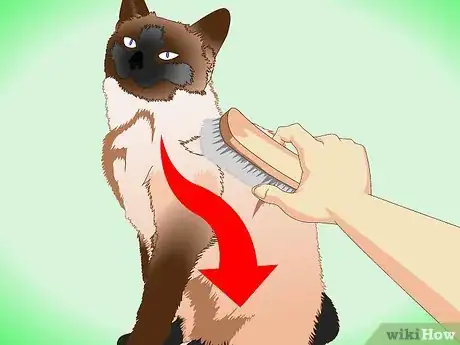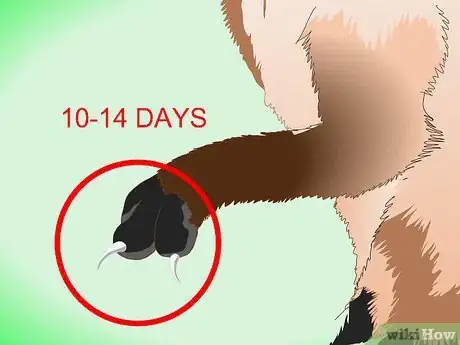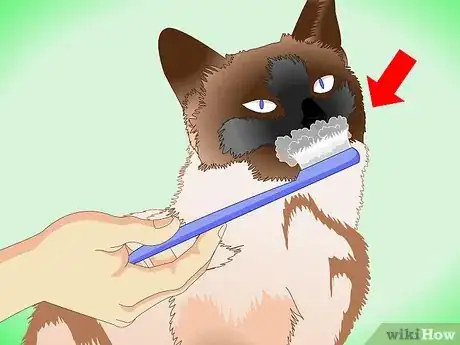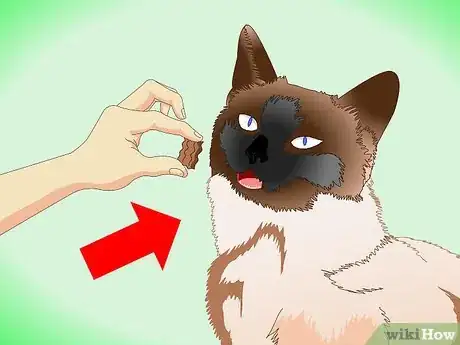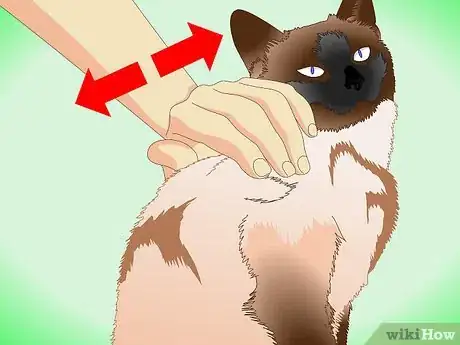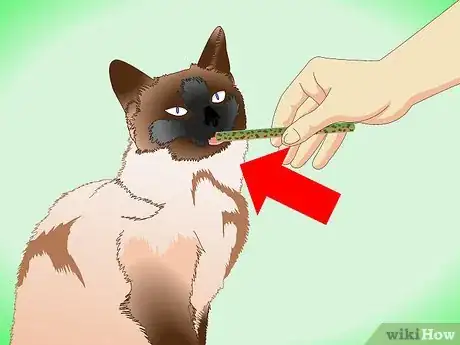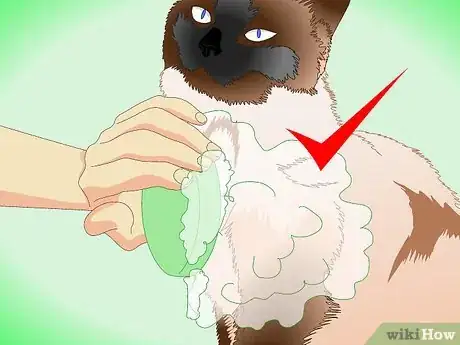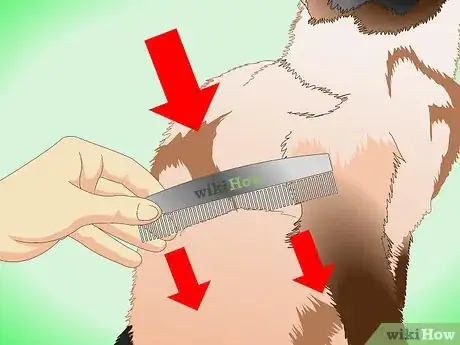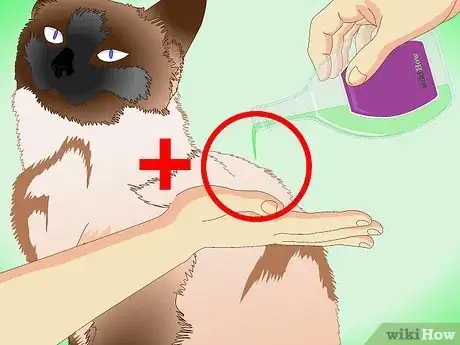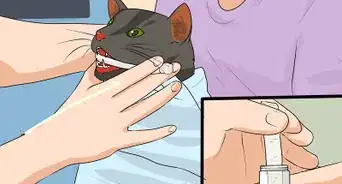This article was co-authored by Daniel Lioy-Ryan, PhD. Dr. Daniel Lioy-Ryan is an Animal Behaviorist and the Co-Founder of Cats in the City. With over a decade of experience, he specializes in understanding animal behavior, safely grooming cats, and working with cats at all life stages. Dr. Lioy-Ryan holds a PhD in Neuroscience from The Oregon Health & Science University.
There are 15 references cited in this article, which can be found at the bottom of the page.
This article has been viewed 36,861 times.
With their short coats and friendly personalities, Siamese cats are fairly easy to groom compared to other cat breeds. However, they do still have some routine grooming needs that need to be met to keep the cat healthy and happy. Learn the basics of grooming Siamese cats and add these easy tasks to your schedule today!
Steps
Basic Grooming Schedule
-
1Brush the cat's coat weekly. With their short hair, Siamese do not shed much and generally don't require a lot of work to keep their coats looking good. However, a quick weekly brushing can help remove loose hair that does accumulate in the coat. Use the tips below to have a successful brushing session:
- Use a gentle brush or comb. A Siamese's coat is quite short, so you don't need much to get it brushed. Many breed aficionados recommend smaller rubber brushes.[1] Use any hard-bristled brushes gently.
- Brush in the direction of hair growth. Going against the grain can be uncomfortable for the cat.[2]
- Go slowly, working through one section of the cat's body at a time. Wipe dead hair from the brush between sections.[3]
- Finish by wiping the cat's coat with a soft towel.
-
2Trim the cat's nails every 10-14 days.[4] Nail maintenance is important for all cats to keep the nails healthy and discourage scratching. This can be intimidating for someone who hasn't done it before, so see WikiHow's guide to trimming a cat's nails if this is your first time. You can find a few basic tips below:
- Use a sharp set of human nail clippers or guillotine-style veterinary clippers.[5] Dull blades can make the process uncomfortable.
- Hold the cat in your lap and gently squeeze its toe to get it to extend its claw.
- Cut the sharp tip off of the nail. Stay away from the quick — the pink park at the base of the nail. Cutting through the quick or near to it is very painful and can result in bleeding.[6]
- Note that many owners clip the rear claws much less frequently than the front ones since cats don't use them for scratching.
Advertisement -
3Brush the cat's teeth daily if possible. It's easy to forget that a cat's teeth need taking care of just like a human's most vets recommend brushing about once a day.[7] However, if you can't keep this schedule, brushing weekly or even monthly is better than nothing at all. A few tips for brushing your cat's teeth include:
- Use specially-formulated toothpaste from the pet store for cats. Don't use human toothpaste. The fluoride in it can make your cat very sick.[8]
- Get your cat used to the experience of having its teeth cleaned by wiping a little of the toothpaste on your finger and gently rubbing its teeth and gums. Do this for a few days before your first brushing.[9]
- Use a soft-bristled cat toothbrush to gently apply the paste to the cat's teeth. Be sure to get the teeth at the back of the mouth and along the sides. Give the cat chances to take short breaks if brushing gets uncomfortable.
-
4Schedule vet visits yearly or bi-yearly. Visits to the vet aren't exactly grooming tasks themselves, but they can affect the way you groom your cat. Regular checkups give the vet a chance to catch health problems early, including those that can change your cat's grooming needs (like skin diseases, etc.). In addition, vets can recommend grooming techniques and resources to help keep your Siamese healthy and happy.[10]
- The exact schedule you should use for taking your cat to the vet depends on its current health situation. If your cat is healthy, its age is the main factor that affects its vet schedule. See below:[11]
- 0-4 months old: Monthly visits
- 4 months-7 years old: Visits once or twice per year
- 7-10 years old: Visits twice per year
- Past 10 years old: Visits every 3 months; more often as age-related health problems develop
-
5Get regular dental cleanings to maintain oral health. Just like people, cats occasionally need to visit the dentist to keep their teeth clean and healthy. Veterinary dentists have access to techniques and tools that allow them to give your Siamese's mouth a "deep" cleaning — much more thoroughly than you'll be able to do with a toothbrush and paste.[12]
- Again, the exact schedule for dental cleanings depends on the health of your cat's teeth. Cats generally begin to need cleanings at around one year of age. After this, most vets will recommend cleanings every few years if the cat's teeth are kept healthy. However, if dental problems develop, cleanings can be needed as often as two or three times per year.[13]
Troubleshooting Common Problems
-
1Offer your Siamese small treats after grooming sessions. There's no way around it — most grooming tasks are at least a little unpleasant for the cat. This can lead the cat to struggle, squirm, and even lash out.[14] Giving the cat a treat after you're done grooming it can help it associate the grooming process with positive feelings. Be consistent with your treat-giving and your cat may even begin to look forward to being groomed.
- Siamese cats generally like the same treats as other cats. Try offering small bits of cheese, cooked tuna, chicken or catnip as rewards.[15] Give treats sparingly — they shouldn't make up more than 10% of a cat's calories.
-
2If your cat resists grooming, use calming strategies. If your cat can't seem to relax as it's being groomed, you may want to reconsider how and when you are grooming it. See below for suggestions:[16]
- Groom your cat when it usually has low energy (like before bed or when it's tired out).
- Talk to your cat in a calm, soothing voice as you groom it.
- If your cat is affectionate, offer it lots of petting and give it breaks. If it isn't, work quickly but gently.
- Watch your cat's body language. If you notice your cat pinning its ears back (flattening them against its head), the area you're grooming may be sensitive.
-
3Consider having a professional trim your cat's nails. Because trimming a cat's nails can be tricky and the consequences for screwing up can be very painful for your cat, many owners opt to have an expert do it instead. Most pet groomers that accept cats will be willing to offer this service. Veterinarians will also sometimes do this for free at checkups.
-
4Try a finger wrapped in gauze if your cat doesn't like a toothbrush. Some cats never get over having a hard plastic toothbrush thrust into their mouths. As an alternative, you can put a bit of gauze or a rag over your finger and apply a dab of toothpaste to the end. Carefully scrub around the cat's teeth, paying special attention to the teeth at the back and sides of the mouth. Work your finger gradually and gently into the cat's mouth, then go as quickly as possible for your cat's comfort.
-
5Look for food and water additives for oral health help. Another tool to help keep your cat's mouth clean when it hates using a toothbrush is to use special foods designed to clean its teeth. You may be able to find these foods and additives at pet stores, but talk to your veterinarian before using them to ensure they are safe for your pet's diet. [17]
- As a good rule of thumb, products that have the Veterinary Oral Health Council (VOHC) seal of approval on the packaging should be suitable for most cats, including Siamese.
Special Grooming Circumstances
-
1Give baths only when the cat is especially dirty. Most Siamese cats do a good job of cleaning themselves when they're a little dirty. However, when they're extra dirty or they've gotten into something sticky, they may need a little help. Use these steps to make the bathing process as easy as possible:[18]
- Use the calming techniques in the section above to get your cat into a mellow mood.
- Put down a rubber mat in the sink or tub so your cat doesn't slip.
- Use a spray hose to gently wet your cat's fur.[19] Don't spray into the eyes, ears, or face.
- Use a solution of one part pet shampoo to five parts water to work up a lather in your pet's fur. Don't use human shampoo, which can be hard on a cat's skin.
- Rinse well to remove the shampoo. Dry gently with a clean rag or towel.
-
2Work out matted patches of hair carefully. Siamese cats are unlikely to get matted hair because their fur is so short. However, if they do get matted hair in one of the few spots where their fur grows thicker (like around the jowls of male cats), it's nice to know how to get rid of the matting without hurting the cat. See below:
- Use the tips of a Greyhound comb — a thin-toothed metal comb — to gently tug at the mat.
- Gradually work from the edge of the matted section to the center, loosening the hair if you go.
- Resist the urge to thrust the comb into the mat and yank it out. This can be very painful for your cat.
- If your pat becomes antsy or uncomfortable, give it a short break and plenty of affection before starting again.
-
3Apply a conditioner to the coat for gorgeous presentation. As noted above, Siamese cats don't need a lot of work to keep their coats looking good. However, if you want your cat to look especially presentable (like if you're entering it in a show), specially conditioners can leave the coat with a warm, shiny finish. Follow the directions on the packaging for proper use — often, all you'll need to do is rub it in with your hands or a towel.
- Note that cat conditioners can be somewhat expensive. A small bottle can cost more than $20.[20]
Community Q&A
-
QuestionHow many times do I groom a Siamese in a week?
 Community AnswerSiamese have very short hair. A good amount would be one to two times a week.
Community AnswerSiamese have very short hair. A good amount would be one to two times a week. -
QuestionCan I give milk to a Siamese kitten?
 Community AnswerA majority of cats are sensitive to lactose, including many Siamese kittens, so you should avoid giving them milk if possible.
Community AnswerA majority of cats are sensitive to lactose, including many Siamese kittens, so you should avoid giving them milk if possible. -
QuestionAt cat shows Siamese owners used to wipe their cats' coats with Listerine. Which kind of Listerine should I buy?
 Community AnswerThe make a specific one. Walmart carries it, but you should call to confirm.
Community AnswerThe make a specific one. Walmart carries it, but you should call to confirm.
References
- ↑ http://www.nationalsiamese.com/groom.htm
- ↑ https://www.aspca.org/pet-care/cat-care/cat-brushing-skin-care
- ↑ https://www.aspca.org/pet-care/cat-care/cat-brushing-skin-care
- ↑ http://www.vetstreet.com/cats/siamese#grooming
- ↑ http://www.vetmed.wsu.edu/ClientED/cat_claws.aspx
- ↑ http://www.vetmed.wsu.edu/ClientED/cat_claws.aspx
- ↑ http://www.petmd.com/blogs/thedailyvet/jcoates/2011/sept/brushing_cats_teeth_every_day-11647
- ↑ http://www.petmd.com/cat/slideshows/grooming/top-ten-tips-on-how-to-keep-your-cats-teeth-clean
- ↑ https://www.aspca.org/pet-care/cat-care/ten-steps-dental-health
- ↑ http://pets.webmd.com/features/well-visits-cats
- ↑ http://pets.thenest.com/should-indoor-cat-vet-4434.html
- ↑ http://www.vcahospitals.com/main/cat-care/health-and-wellness/cat-dental-care/teeth-cleaning
- ↑ http://www.vcahospitals.com/main/cat-care/health-and-wellness/cat-dental-care/teeth-cleaning
- ↑ Daniel Lioy-Ryan, PhD. Animal Behaviorist. Expert Interview. 17 August 2021.
- ↑ http://pets.webmd.com/cats/guide/cat-treats-and-snacks-whats-healthy
- ↑ http://www.catster.com/cat-grooming/
- ↑ http://www.petmd.com/blogs/thedailyvet/jcoates/2011/sept/brushing_cats_teeth_every_day-11647
- ↑ https://www.aspca.org/pet-care/cat-care/bathing-your-cat
- ↑ Daniel Lioy-Ryan, PhD. Animal Behaviorist. Expert Interview. 17 August 2021.
- ↑ https://www.amazon.com/Miracle-Coat-Leave-In-Conditioner-Lusterizer/dp/B000X95EKE?th=1
About This Article
To groom a Siamese cat, schedule a weekly time to brush your cat’s coat so it’s easy to keep in good shape. Use a gentle, small rubber brush, as this type of brush is ideal for the short coat of the Siamese breed and won’t dig into the cat’s skin. Make sure to always brush in the direction that the cat’s hair grows, otherwise it may feel uncomfortable for your cat. Work through one section of the cat’s body at a time, brushing slowly. For example, begin at the tail end, brushing the tail, then brush the rear legs and top of the cat’s rear back before moving to the middle section, then the head section. Remove hair from the brush occasionally to keep the brush effective. Once brushing is done, wipe your cat’s whole coat with a soft towel. For more tips, including how to fix matted hair, keep reading!
